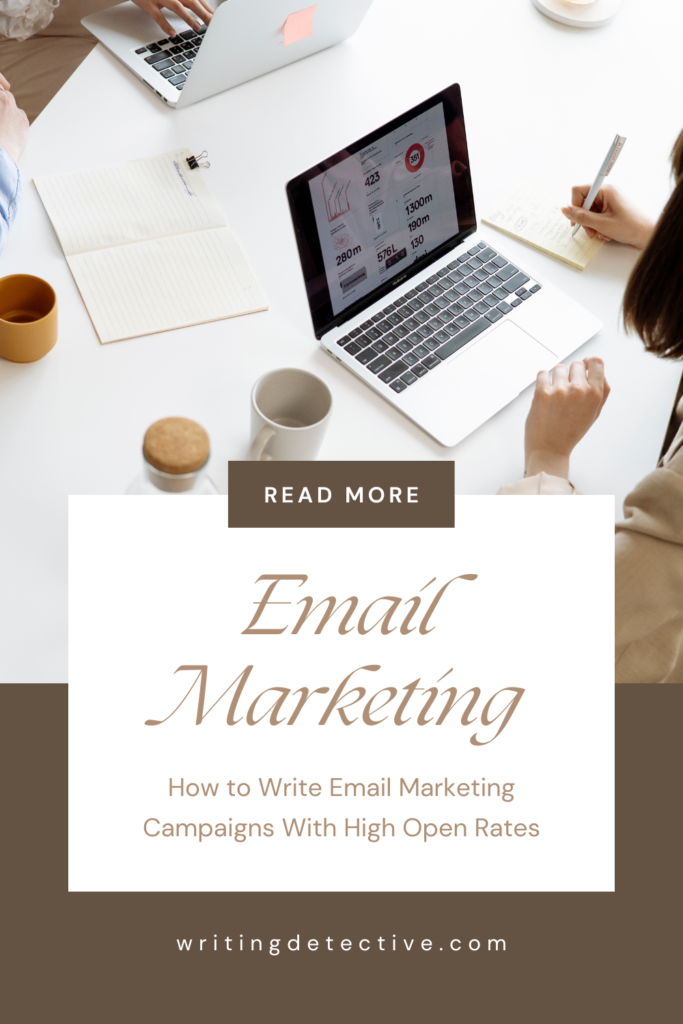Email marketing is one of the most effective ways to reach your target audience, build relationships, and drive conversions. However, with the average person receiving dozens of emails every day, it can be challenging to stand out in a crowded inbox. The key to successful email marketing lies in crafting campaigns that entice recipients to open and engage with your content.

Understand Your Target Audience
Before you start crafting your email marketing campaign, it’s crucial to have a deep understanding of your target audience. Knowing your recipients’ interests, pain points, and preferences will help you create content that resonates with them.
To gain insights into your audience, consider the following:
- Analyze your existing customer data, such as demographics, purchase history, and email engagement metrics.
- Conduct surveys or polls to gather feedback and learn more about your subscribers’ preferences.
- Create buyer personas that represent your ideal customers, including their goals, challenges, and communication styles.
By tailoring your email content to your audience’s needs and interests, you’ll be more likely to capture their attention and encourage them to open your emails.

Craft Compelling Subject Lines
Your subject line is the first impression your email makes on a recipient. It’s the gateway to your email’s content, and it can make or break your open rates. A compelling subject line should be concise, attention-grabbing, and relevant to your audience.
Here are some tips for crafting effective subject lines:
- Keep it short and sweet: Aim for subject lines that are around 50 characters or less, as longer subject lines may get cut off in some email clients.
- Be clear and descriptive: Your subject line should give recipients a clear idea of what your email is about without being too vague or cryptic.
- Use action-oriented language: Incorporate verbs that encourage recipients to take action, such as “Discover,” “Unlock,” or “Save.”
- Personalize when possible: Address recipients by name or reference their specific interests to make your subject lines more engaging.
- Create a sense of urgency: Use time-sensitive language or limited-time offers to encourage recipients to open your emails promptly.
- Test different variations: Experiment with different subject line styles, lengths, and formats to see what resonates best with your audience.
Remember, your subject line should accurately reflect the content of your email. Avoid using clickbait or misleading subject lines, as they can erode trust and lead to unsubscribes.
Optimize Your Sender Name and Preview Text
In addition to your subject line, your sender name and preview text can also influence whether recipients choose to open your emails.
Your sender name should be easily recognizable and associated with your brand. Use a consistent sender name across all your email campaigns to build familiarity and trust with your audience.
Preview text, also known as preheader text, is the short snippet of text that appears next to or below the subject line in most email clients. This text provides additional context and can entice recipients to open your email. Consider the following when optimizing your preview text:
- Keep it concise, typically around 50-100 characters.
- Use it to expand upon your subject line and provide more details about your email’s content.
- Include a call-to-action or highlight a key benefit to encourage opens.
- Ensure it flows naturally from your subject line and doesn’t feel disjointed.
By optimizing your sender name and preview text, you can create a cohesive and compelling first impression that encourages recipients to open your emails.
Segment Your Email List
Not all subscribers are the same, and sending a one-size-fits-all email campaign can lead to low open rates and engagement. By segmenting your email list, you can deliver more targeted and relevant content to specific groups of subscribers based on their interests, behavior, or demographics.
Here are some common ways to segment your email list:
- Demographics: Segment based on age, gender, location, or job title to tailor your content to specific groups.
- Interests: Group subscribers based on their expressed interests or the types of content they engage with most frequently.
- Purchase history: Segment customers based on their past purchases, such as product categories or price points, to send more relevant product recommendations or promotions.
- Email engagement: Create segments based on subscribers’ email engagement, such as open rates or click-through rates, to identify your most active and engaged subscribers.
- Subscriber lifecycle: Segment based on where subscribers are in their journey with your brand, such as new subscribers, loyal customers, or inactive subscribers.
By sending targeted email campaigns to specific segments, you can deliver more relevant and valuable content that resonates with your audience, leading to higher open rates and engagement.
Optimize for Mobile Devices
With more than half of all emails being opened on mobile devices, it’s crucial to ensure your email campaigns are optimized for mobile viewing.
Here are some tips for creating mobile-friendly emails:
- Use a responsive email template that adapts to different screen sizes and devices.
- Keep your email design simple and clean, with a single-column layout that’s easy to read on smaller screens.
- Use a larger font size (at least 14px) to ensure readability on mobile devices.
- Make your call-to-action buttons large and prominent, with ample spacing to avoid accidental clicks.
- Optimize images for mobile by compressing them to reduce load times and ensuring they scale properly on different devices.
- Test your email campaigns on various mobile devices and email clients to ensure a consistent and user-friendly experience.
By creating mobile-friendly email campaigns, you’ll make it easier for recipients to engage with your content on the go, leading to higher open rates and better overall performance.

Write Engaging Email Copy
Once you’ve enticed recipients to open your email, your email copy needs to deliver on the promise of your subject line and keep them engaged. Here are some tips for writing compelling email copy:
- Keep it concise and scannable: Use short paragraphs, bullet points, and subheadings to break up your content and make it easy to read.
- Focus on benefits, not just features: Highlight how your product or service can solve your recipients’ problems or improve their lives, rather than simply listing features.
- Use a conversational tone: Write as if you’re speaking directly to your recipient, using a friendly and relatable tone that builds a connection.
- Personalize your content: Use merge tags to incorporate recipients’ names or other personalized details to make your emails feel more tailored to their interests.
- Include a clear call-to-action: Make it easy for recipients to take the next step, whether it’s making a purchase, downloading a resource, or visiting your website.
- Test different copy variations: Experiment with different headlines, body copy, and calls-to-action to see what resonates best with your audience.
By crafting engaging email copy that speaks directly to your audience’s needs and interests, you’ll keep them interested in your content and more likely to take action.
Test and Optimize Your Email Campaigns
To continually improve your email open rates, it’s essential to test and optimize your campaigns regularly. Here are some elements you can test:
- Subject lines: Try different subject line styles, lengths, and formats to see what generates the highest open rates.
- Sender name and preview text: Experiment with different sender names and preview text variations to find the most effective combinations.
- Email design and layout: Test different email templates, color schemes, and imagery to see what resonates best with your audience.
- Calls-to-action: Try different CTA placements, copy, and button designs to optimize for clicks and conversions.
- Sending times and frequency: Test different days of the week and times of day to find the optimal sending schedule for your audience.
When testing, be sure to use A/B testing methods, where you send different variations of your email to a small portion of your list and compare the results. This allows you to make data-driven decisions and continually refine your email marketing strategy.
Monitor and Analyze Your Email Metrics
To measure the success of your email marketing campaigns and identify areas for improvement, it’s crucial to monitor and analyze your email metrics regularly. Key metrics to track include:
- Open rate: The percentage of recipients who opened your email.
- Click-through rate (CTR): The percentage of recipients who clicked on a link within your email.
- Conversion rate: The percentage of recipients who completed a desired action, such as making a purchase or filling out a form.
- Bounce rate: The percentage of emails that couldn’t be delivered to recipients’ inboxes.
- Unsubscribe rate: The percentage of recipients who unsubscribed from your email list after receiving a particular campaign.
By monitoring these metrics over time, you can identify trends, spot areas for improvement, and make data-driven decisions to optimize your email marketing strategy.
Bonus Tips for Boosting Email Open Rates
In addition to the strategies outlined above, here are a few bonus tips to help you further improve your email open rates:
- Leverage the power of personalization: Beyond just using recipients’ names, consider personalizing your email content based on their interests, past purchases, or behavior. This can help make your emails feel more relevant and tailored to their needs.
- Create a sense of exclusivity: Make your subscribers feel special by offering exclusive content, early access to sales, or member-only perks. This can help build anticipation and encourage them to open your emails more consistently.
- Use social proof: Incorporate customer testimonials, case studies, or user-generated content in your emails to build trust and credibility with your audience. Seeing how others have benefited from your product or service can be a powerful motivator for recipients to engage with your content.
- Experiment with different email formats: While traditional email campaigns can be effective, consider testing other formats like plain-text emails, interactive emails, or even video emails to see what resonates best with your audience.
- Regularly clean your email list: Over time, your email list may accumulate inactive or unengaged subscribers. Regularly cleaning your list by removing bounced or inactive email addresses can help improve your overall deliverability and open rates.
By incorporating these bonus tips into your email marketing strategy, you’ll be well on your way to creating campaigns that consistently generate high open rates and drive meaningful results for your business.

Final Thoughts
Crafting email marketing campaigns with high open rates requires a combination of strategic planning, audience insights, and ongoing optimization. By understanding your target audience, crafting compelling subject lines and preview text, segmenting your email list, optimizing for mobile devices, writing engaging email copy, testing and optimizing your campaigns, and monitoring your email metrics, you can create email campaigns that stand out in a crowded inbox and drive meaningful results for your business.
Email marketing is not a one-size-fits-all approach. What works for one audience may not work for another, so it’s crucial to continually test, refine, and adapt your strategy based on your unique insights and data.
By staying committed to delivering valuable, relevant content to your subscribers and building long-lasting relationships based on trust and mutual benefit, you’ll be well on your way to creating email marketing campaigns that consistently generate high open rates and drive success for your business.






